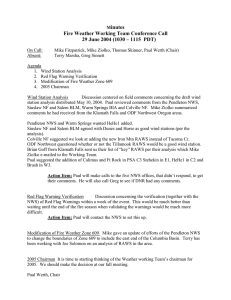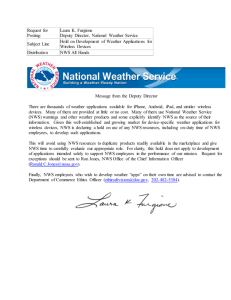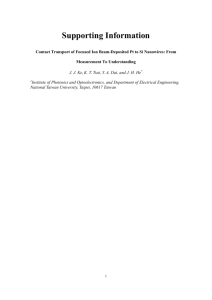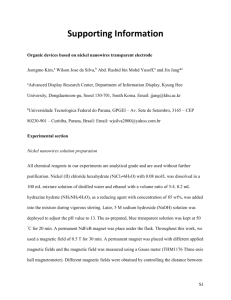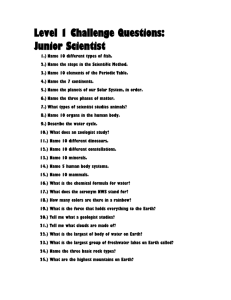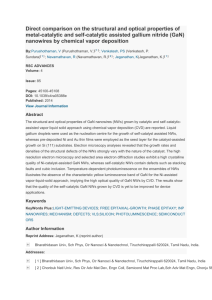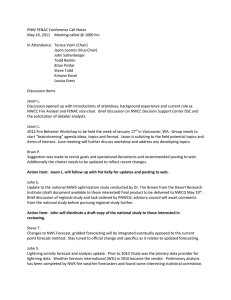MINUTES Spring 2004 PNWCG Fire Weather Working Team / NWS Meeting
advertisement
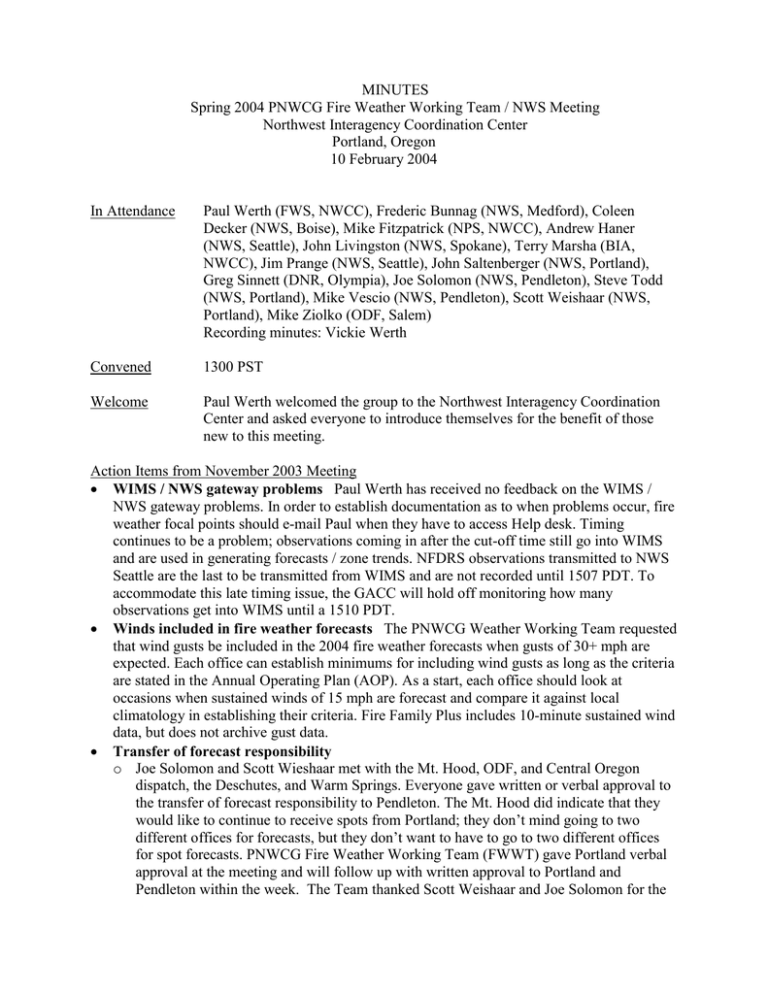
MINUTES Spring 2004 PNWCG Fire Weather Working Team / NWS Meeting Northwest Interagency Coordination Center Portland, Oregon 10 February 2004 In Attendance Paul Werth (FWS, NWCC), Frederic Bunnag (NWS, Medford), Coleen Decker (NWS, Boise), Mike Fitzpatrick (NPS, NWCC), Andrew Haner (NWS, Seattle), John Livingston (NWS, Spokane), Terry Marsha (BIA, NWCC), Jim Prange (NWS, Seattle), John Saltenberger (NWS, Portland), Greg Sinnett (DNR, Olympia), Joe Solomon (NWS, Pendleton), Steve Todd (NWS, Portland), Mike Vescio (NWS, Pendleton), Scott Weishaar (NWS, Portland), Mike Ziolko (ODF, Salem) Recording minutes: Vickie Werth Convened 1300 PST Welcome Paul Werth welcomed the group to the Northwest Interagency Coordination Center and asked everyone to introduce themselves for the benefit of those new to this meeting. Action Items from November 2003 Meeting WIMS / NWS gateway problems Paul Werth has received no feedback on the WIMS / NWS gateway problems. In order to establish documentation as to when problems occur, fire weather focal points should e-mail Paul when they have to access Help desk. Timing continues to be a problem; observations coming in after the cut-off time still go into WIMS and are used in generating forecasts / zone trends. NFDRS observations transmitted to NWS Seattle are the last to be transmitted from WIMS and are not recorded until 1507 PDT. To accommodate this late timing issue, the GACC will hold off monitoring how many observations get into WIMS until a 1510 PDT. Winds included in fire weather forecasts The PNWCG Weather Working Team requested that wind gusts be included in the 2004 fire weather forecasts when gusts of 30+ mph are expected. Each office can establish minimums for including wind gusts as long as the criteria are stated in the Annual Operating Plan (AOP). As a start, each office should look at occasions when sustained winds of 15 mph are forecast and compare it against local climatology in establishing their criteria. Fire Family Plus includes 10-minute sustained wind data, but does not archive gust data. Transfer of forecast responsibility o Joe Solomon and Scott Wieshaar met with the Mt. Hood, ODF, and Central Oregon dispatch, the Deschutes, and Warm Springs. Everyone gave written or verbal approval to the transfer of forecast responsibility to Pendleton. The Mt. Hood did indicate that they would like to continue to receive spots from Portland; they don’t mind going to two different offices for forecasts, but they don’t want to have to go to two different offices for spot forecasts. PNWCG Fire Weather Working Team (FWWT) gave Portland verbal approval at the meeting and will follow up with written approval to Portland and Pendleton within the week. The Team thanked Scott Weishaar and Joe Solomon for the trip report and documentation of acceptance of changes. It is well done and exactly what the FWWT needs. o Pendleton’s fire weather zone 631 is very large zone. The Mt. Hood, southeast DNR and ODF (the Dalles) would agree with re-extending Zone 609 northward along Highway 197 across the Columbia River and abutting Zone 681. The east boundary in Klickitat County is yet to be determined. This is not likely to happen this year. The group discussed the concept of changing zones without specific criteria for doing so. It was agreed that they don’t want to change zones from year to year. This will be a good opportunity to reevaluate all zone boundaries in Washington and Oregon. As the Weather Service Offices finalize their Annual Operating Plans, they are requested to be specific about how Red Flag Warnings are verified; that is, to strive to achieve seamless Red Flag and verification criteria. 2004 changes in the Annual Operating Plan Medford picked up the Charlotte Ridge (ODF) RAWS station in Zone 615. Frederic Bunnag is Medford’s only IMET this year, and they have lost a fire weather forecaster. Their MIC is retiring. They plan no criteria changes. Boise has mostly administrative changes. Phone and fax numbers have changed, and Coleen Decker is the new Fire Weather Forecaster. They were thinking about combining Zones 636 and 637 for Red Flag Warning verification purposes, but the Burns and Vale BLM districts didn’t agree to that. Boise wants to have two RAWS sites in Vale and three in Burns for verification purposes. Their new phone number as of 01 April 2004 will be 334-9060. They will still have the old fax number operational, but as of 01 April their primary fax number will be 208-334-1662. Colleen’s e-mail address is coleen.decker@noaa.gov Pendleton reported that John Dickerson and one new lead forecaster will do fire weather forecasts in addition to the staff that did them last year. They plan no changes in their red flag criteria. Portland noted that Kirstin Willman will join the staff in providing fire weather forecasts. Because wind criteria can’t be met in some zones, Portland is working with Terry Marsha regarding the use of RAWS in adjacent zones for wind and humidity (RH) verification. They will use a couple of key stations to verify in each area. These will be specifically detailed in the AOP. Seattle expects to have six forecasters doing fire weather, though they have not yet confirmed Danny Mercer as a fire weather forecaster. The Red Flag criteria are underlined and bolded in the AOP to make them easier to find. Lightning resulting from a front coming in after a dry spell will be tracked separately from dry lightning. Spokane reported that Gary Bennett retired and Bob Tobin is now onboard. They will operate with the same IMETs and same forecast staff with no changes to RAWS sites or Red Flag criteria. Washington DNR will have twenty RAWS stations this year. They are putting a new RAWS in Chehallis. Enumclaw (South Puget Region Office) will also have a RAWS. DNR is trying to provide ortho photos from Washington State to NWCC. Greenwater has shown a dramatic drop in wind speed, which is probably due to the quality of maintenance. They are combining Central and Southwest Regions into the Pacific Cascade Region, giving them a total of six regions statewide, rather than seven. Will there be a standard AOP format for all offices? Gerry Day would like to have each office include a section for new changes at the front and an appendix for information PNWCG / NWS Weather Working Team Meeting Page 2 10 - 11 February 2004 common to all offices at the end. Each office should e-mail John Saltenberger at the GACC as soon as possible, and no later than March 1st, with their AOP in Word format. Anyone who has their draft with them at this meeting should give it to John today so he can begin working on the combined format. John agreed to incorporate hyperlinks within the .pdf document to allow the reader to easily jump to each office’s section. Red Flag Warning Criteria Offices are encouraged to be very specific in the AOP about Red Flag criteria for verification purposes. It is very confusing to evaluate red flag warnings or missed warnings when the numbers of hours needed to verify are not specified. Does one hour verify the occurrence of a red flag event, or multiple hours? Offices need to evaluate weather records to determine how long typical wind patterns last. On the east side, three hours may be a difficult number for synoptic scale wind events. Boise uses three hours or more as their criteria. Offices should document situations in which a Red Flag Warning is not put out because the customer didn’t feel it was warranted due to high fuel moisture. Such occurrences can be documented in the offices’ daily fire weather log. A compiled report detailing these situations should be sent to the GACC meteorologists so that they can take that into consideration when doing verification. Fuels are a major factor in the Red Flag equation. How can that be objectively stated in the Red Flag criteria? Spokane only specifies dry fuels in their criteria. Seattle uses the 90th percentile of the ERC which incorporates both live and dead fuel moisture. The FWWT will contact PNWCGs Fire Use and Fuels Management Working Team for guidance in establishing fuel moisture criteria for use in Red flag Warnings. Offices should contact their local media about Red Flag Warnings and let them know whom they should contact for accurate information when a warning is issued. Fire Weather Forecaster Proficiency and Currency Standards The MOU has an appendix that addresses fire weather forecaster proficiency and currency standards. The MOU details requirements for the fire weather forecaster, IMET, and fire weather program leader. Prior to the beginning of the season each office should submit a list to the FWWT of their fire weather forecasters who meet the requirements. RAWS Wind Analysis Terry Marsha distributed a list of key stations developed by PNWCG’s Weather Working Team over an extended period. This list was originally developed to determine the minimum network necessary to form the backbone of a fire danger rating system. Wind data was evaluated based upon 95% minimum daily peak wind speed and minimum dispersion (variance) to determine good wind stations, which are denoted in the list with a “W.” Predictive Service Areas (PSAs) have similar climates and are used in the Pacific Northwest in determining NFDRS fire danger ratings. Good key stations, based on humidity data, are denoted with a “Y.” This list of highest priority stations can be used in allocating funds for station maintenance and decisions as to which stations should not be eliminated for budgetary reasons. This illustrates station efficiency and would enable RAWS station sponsors to eliminate redundancy. It gives a solid basis for determining the most important stations. This list is not final, and it does not imply that stations not on the list should not be funded. This list may also be useful in determining which stations can or should be used for Red Flag verification. Adjourned 1630 PDT PNWCG / NWS Weather Working Team Meeting Page 3 10 - 11 February 2004 MINUTES Spring 2004 PNWCG Weather Working Team / NWS Meeting Northwest Interagency Coordination Center Portland, Oregon 11 February 2004 In Attendance Paul Werth (FWS, NWCC), Frederic Bunnag (NWS, Medford), Coleen Decker (NWS, Boise), Mike Fitzpatrick (NPS, NWCC), Andrew Haner (NWS, Seattle), John Livingston (NWS, Spokane), Terry Marsha (BIA, NWCC), Jim Prange (NWS, Seattle), John Saltenberger (NWS, Portland), Greg Sinnett (DNR, Olympia), Joe Solomon (NWS, Pendleton), Steve Todd (NWS, Portland), Mike Vescio (NWS, Pendleton), Scott Weishaar (NWS, Portland), Mike Ziolko (ODF, Salem) Recording minutes: Vickie Werth Convened 0800 PST Questions from 10 February 2004 Red Flag criteria – Scott noted that a lot of missed warnings were counted by Portland that were not counted by the GACC for verification. This was due to an omission of criteria in the 2003 AOP that stated 25% and not 35% as the threshold RH values for daytime Westside red flag events. Mike Ziolko reported that effective 01 April 2004 NWS can provide spot forecasts for public safety or prescribed fires on private lands that go beyond normal wildland fire responsibilities. Section 4.2.2 of the Fire Weather Services Product Specification details the circumstances that apply. This needs to be addressed in the changes section of the AOP and also in the body of each offices plan. The electronic spot forecast web page now includes two additional options for the type of spot forecast being requested. The link to this form will still be available from NWS fire weather pages. The group discussed restricting ability to view and request spot forecasts dependent upon security access. The purpose for doing so would be to protect the web page from multiple access attack. A couple of offices have received bogus requests. They have acceded to the request with a notation that this site is for official use only and that unauthorized requests take time away from valid users. They now plan to telephone the contact for requests that look suspicious. Some NWS offices will be using IFPS as “first guess” values for spot forecasts according to a new spot program developed at Billings. Paul Werth asked if the accuracy of these IFPS values have been evaluated prior to this implementation. The answer was that these IFPS values have not been evaluated. Coleen Decker reported that Chuck Redman is not present because he is attending a joint Easter Great Basin/GACC AOP meeting. They are trying to define a broad-brush approach to Red Flag criteria based on wind gusts of at least 25 mph and relative humidity less than or equal to 15% for three hours. PNWCG / NWS Weather Working Team Meeting Page 4 10 - 11 February 2004 Dry Lightning Research Paul Werth distributed copies of a paper detailing research performed by Miriam Rorig and Sue Ferguson begun in 1998. They concentrated on predictors that would discriminate between wet and dry lightning based on upper air and rainfall data from Spokane. A dry thunderstorm was defined as storms that produce a tenth of an inch of rain or less. This study is probably representative of the Columbia Basin, but not in the surrounding mountains. Some of the results of the study include: a lack of relationship between flash polarity (negative versus positive) and fire starts, lightning is more efficient in starting timber fires rather than range fires, and low fuel moisture seems to be a major factor in the number and size of lightning fires. This has particular application to Terry Marsha’s research on fuel moisture and the probability of fires. A lightning fire map of the region shows a donut hole in the Columbia Basin that is directly related to available fuels. The parameters for their research are summarized in chart form. Paul showed a slide where he overlaid a low-mid elevation Haines Index chart over Miriam and Sue’s wet and dry lightning chart. There appears to be good correlation between their dry lightning areas to moderate and high Haines Index areas. He noted that it is possible to go from a Haines 4 to 6 without going to a 5, or a 3 to 5 without a 4. This is due to the fact that the Haines Index is very course due to the threshold values that are used to calculate the index. This is the first time that the Haines Index has been charted in this manner. A second paper detailing research performed by Miriam Rorig and Sue Ferguson entitled Forecasting Dry Lightning in the Western United States focuses on Albuquerque and Denver. Paul again overlaid a Haines Index chart, this time for high elevation, over Miriam and Sue’s wet and dry lightning chart which again shows a significant correlation. There are three ways to achieve a Haines Index of 4: stable dry air, moist unstable air, and moderately unstable and moist air. The Haines Index of 4 in the 80% probability of dry lightning area was surprising. The GACC web page will have a link the Pacific Northwest MM5 web page that will have graphics depicting areas of dry lightning using Miriam and Sue’s algorithms this year. It would be interesting to see a similar study using Boise data. Dryness Levels Terry Marsha explained that the goal of GACC Predictive Services is to keep wildland fire agency managers apprised of potential for serious fire activity, that is, the probabilities of breaking large fires. Center and regional office managers use this information to determine where to preposition resources. A large fire in each district is defined as 50 acres or the 95th percentile of fire size in a Predictive Service Areas (PSAs), a figure arrived at by statistical analysis of the zones. There is no differentiation between range and timberlands because that is taken care of through the definition. In the past, fire danger and fuel moisture values were chosen without regard to fire business. Lately (in the past couple of years), there has been a push to use NFDRS output that correlates to fire activity. Large fire days are correlated with fuel dryness levels, which are predicated using Energy Release Component (ERCs) and 100-hour fuel moistures. The dryness level statistics chart indicates that, in a general sense: when in the green level, there is an extremely low likelihood of needing to put out a Red Flag warning; when in the yellow level, the need for a Red flag Warning is still small; however, when in the red level, the issuance of a red flag Warning should be considered when there is a weather trigger. PNWCG / NWS Weather Working Team Meeting Page 5 10 - 11 February 2004 The best predictor of large fire days is the number of ignitions. Eighty to ninety percent of all large fire episodes are caused by lightning. Many factors, which cannot be addressed here, account for wildfires becoming big. These factors include firefighting strategies, resource availability, politics, wilderness areas, etc. The GACC puts out a Predicted 10-Day Large Fire Potential by Area Chart every day during the fire season that illustrates weather triggers in conjunction with dryness. GFS model data is used to project both the fuel dryness and weather triggers for this product. The lightning symbols on this chart indicate problem lightning, not just lightning. Chart color and significant lightning (lightning the forecaster thinks is going to be more than isolated) are the criteria for determining problem lightning. The criteria for problem lightning are not based on Lightning Activity Levels (LALs) because LALs are also judgment calls. Accurately predicting the potential for large fires allows the forecaster to balance accuracy of predicting large fire potential with keeping the false alarm rate at a minimum, thereby increasing the forecaster’s credibility. Trigger Events 1. Multiple Ignitions (usually lightning) 2. Unstable Atmosphere (Haines Index) 3. Wind A “red” dryness level in conjunction with a trigger event is usually required for large fires. Critical Fire Weather Patterns in the Pacific Northwest Much of the documentation goes back to the early 1960s, but in the early days it didn’t get into upper atmosphere patterns. This information will be incorporated into the new S-490 course. Hot dry weather does not necessarily mean large fire activity. There are four major factors (commonalities) that contribute to critical fire weather. 1. Drought 2. Strong wind 3. Low atmospheric moisture 4. Instability Identify synoptic scale Good publications on Wildland fire activity include: o Synoptic Weather Types Associated with Critical Fire Weather, published in the 1960s o Wildfire Behavior Associated with Upper Ridge Breakdown, 1980s in Alberta, Canada Establishment period (stable air mass, low Haines Index) Initial weakening Final breakdown Examples of upper ridge breakdown are the 1994 South Canyon Fire in Colorado, the 1990 Awbrey Hall Fire in Central Oregon, the 2001 Thirty Mile Fire in north-central Washington, the 2003 B & B Complex in central Oregon, the 16 October 1991 Spokane Firestorm, and the 1999 He He Butte Fire. In most instances, the upper level thermal trough was right above the fire. It is important to watch the surface pressure patterns for the thermal trough. o Fall 2003 Fire Management Today reprinted an article called “Predicting Major Wildland Fire Occurrence” Use of Real-time Observation Monitoring and Analysis Network in Monitoring Red Flag Events The Real-time Observation Monitoring and Analysis Network (ROMAN) was developed through Predictive Services and the University of Utah. There will be a link to this on the GACC website. There are a host of products that use every network of stations available in Oregon and Washington. It is very interactive, allowing modification of multiple fields. Also available are a PNWCG / NWS Weather Working Team Meeting Page 6 10 - 11 February 2004 Red Flag monitor, a precipitation monitor, and weather near fires (very helpful to IMETs on initial dispatch). Announcements Mike Vescio announced that the next National Weather Association meeting will be held 16 - 21 October 2004 at the Doubletree Lloyd Center in Portland, Oregon. Fire Weather Focal Points are encouraged to submit abstracts. The call for abstracts will be published in the association newsletter within the next two weeks and posted at www.nwas.org. Dates for Fall 2004 Meeting 16 November 2004 at 1300 through 17 November 2004 at 1200 Adjourned 1200 PDT Additional Presentation Following the meeting Andrew Haner presented his work on strong wind events in the Okanogan Valley of north-central Washington. The terrain northwest of the Washington border (British Columbia) includes the town of Hope in the Fraser Valley, some lower mountain passes in the Cascades of southern B.C., and the Similkameen River Valley flowing southeast toward the city of Oroville. Data presented is from April 2002, August 2002 and October 2003. An upper ridge with northwesterly flow aloft was over Washington two days before the Okanogan event of April 2002. Twelve hours before the event, on the morning of the 22nd there was flat ridging over the area. On the evening of the 22nd there were 77 mph wind gusts when a cold front jumped the relatively low part of the Cascades in southern British Columbia, came through the Similkameen River Valley, and funneled down into Oroville. Two days before the 16 August 2002 event (that took place between 0100 and 0600) there was an upper ridge off the coast with northwesterly flow through British Columbia and Alberta. There was no four-corners high. Eighteen hours before the event there were 100 knot winds at 500 mb on the Kelowna upper air sounding. High pressure at the surface was beginning to build in behind the upper level ridge. Six hours before the event there was good thermal packing associated with a cold front. The event continued from the Okanogan Valley across the northeast mountains of Washington. The third event took place on the evening of 28 October 2003, a strong upper ridge was in place. A disturbance sailed through the northern Gulf of Alaska (across the top of the ridge). On the morning of the 28th the ridge began to retrograde westward, and the disturbance dove southeast. There was tight thermal packing in association with the event. Oroville experienced gusts of 94 mph. Omak had strong winds at the same time. Andy is still developing a table of observed pressure gradients for these three events. PNWCG / NWS Weather Working Team Meeting Page 7 10 - 11 February 2004 ACTION ITEM SUMMARY ACTION ITEM During July and August 2004, Weather Service Offices will document days on which they do not receive the observations on time. The data should be e-mailed to Paul Werth at the end of each pay period (mid- and late July and mid- and late August). This should include whether the Help Line was contacted and whether they were able to correct the problem. ACTION ITEM An evaluation will be undertaken prior to fire season 2005 to determine criteria for establishing or changing zone boundaries. ACTION ITEM Mike Ziolko and John Saltenberger will address 01 April 04 changes to the AOP regarding the “National Weather Service Instruction 10-401” directive relating to non-federal, non-wildfire use of spot forecasts. ACTION ITEM The group would like to see examples of upper level and surface map types for high fire correlation days posted on the GACC web page so that they could use them in training other weather forecasters at their offices. They would like to have them hyperlinked. An incredibly high number of fires occur when a 500 mb Map Type 9 transitions to a Map Type 2. PNWCG / NWS Weather Working Team Meeting Page 8 10 - 11 February 2004
